A central element of this training method is the combination of tempo, technique and speed, along with technical coordination and passing quality. The Circuit 4 drills target these functional areas through simulations of various attacking combinations that require cohesion between three to five players.
This circuit, which features drills that do not include finishing on goal, provides an uninterrupted rotation of high repetition, high volume physical and technical speed training stimuli, with technical breakdown between players representing the only possible interruption to the exercises. An added benefit of the continuous nature of the drills is the demands it places on players in terms of concentration and focus to avoid a drill from breaking down. In addition, efficiency of movement, the technical balance of two footedness and good footballing awareness habits are all priorities in each drill.
Recurring themes across STC Circuit 4 include penetrating vertical passes played to meet long, high speed runs from deep areas or shorter, angled accelerations all originating off the same line of play, as well as players powering forwards with the ball or turning out to play vertically into the path of players making various angles of acceleration or movement into forward spaces from a higher line.
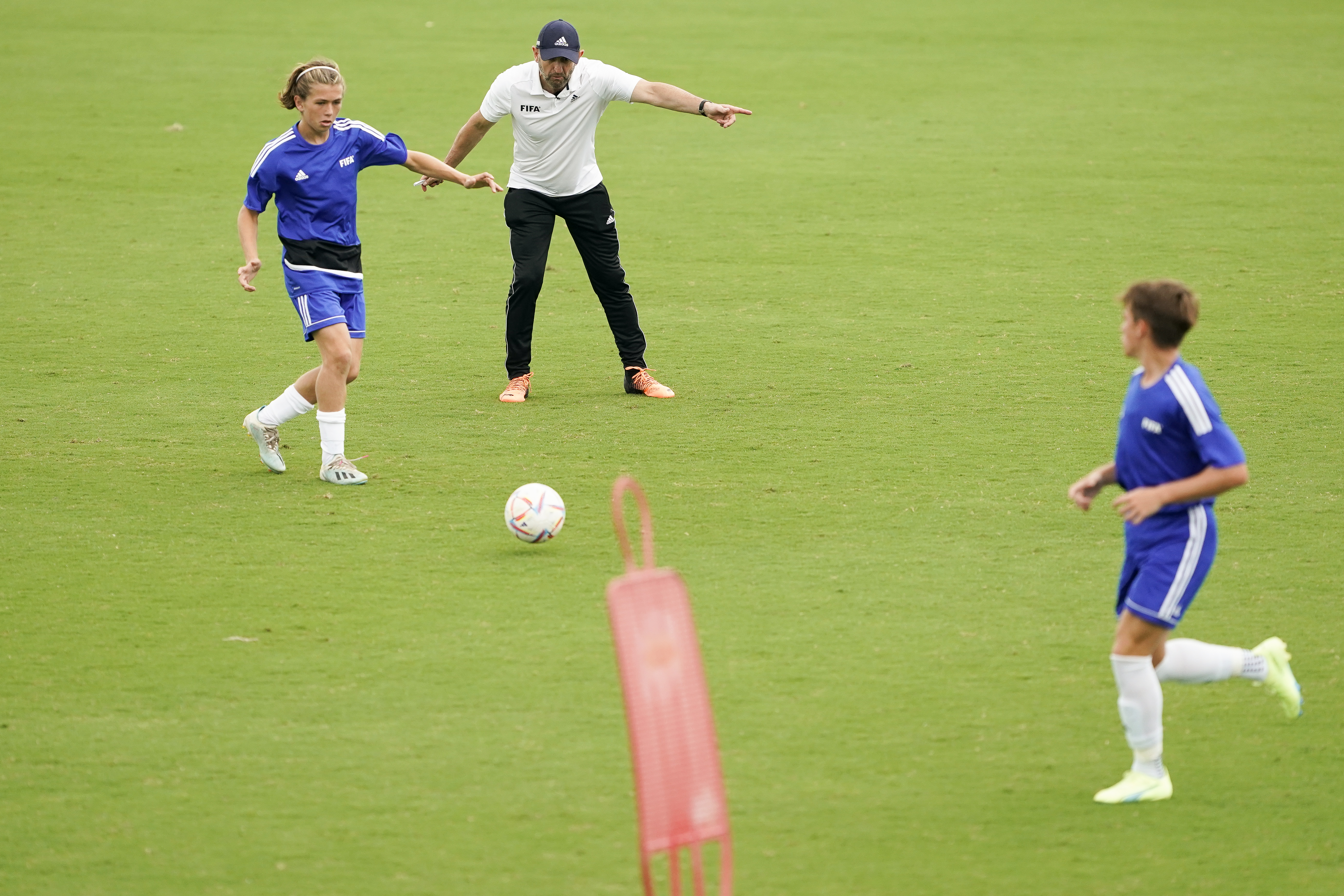
Moving on the half turn forwards to receive before finding the runner in behind or accelerating infield before sweeping the ball into the path of the player making a run from the opposite side of the circuit are simulations of in match movements encountered in these drills. Lastly, three-step passing combinations to find a third player on the move, and a give and-go that involves playing inside to go outside and in behind to meet the return pass make up the remaining exercises within the circuit.
Circuit 4 features four grid sizes (very small, small, medium, large) that reflect the sprint and high speed running (HSR) distances and the passing ranges involved in the drills. The size of the grid should be adapted to the age group.
All drills can be performed using 1 ball in rotation amongst a minimum of 5 players and a maximum of 8 players, or 2 balls in rotation between 10 to 16 players. The fewer the players involved, the greater the overall workload intensity. This applies to the rotations involving both 1 and 2 balls.
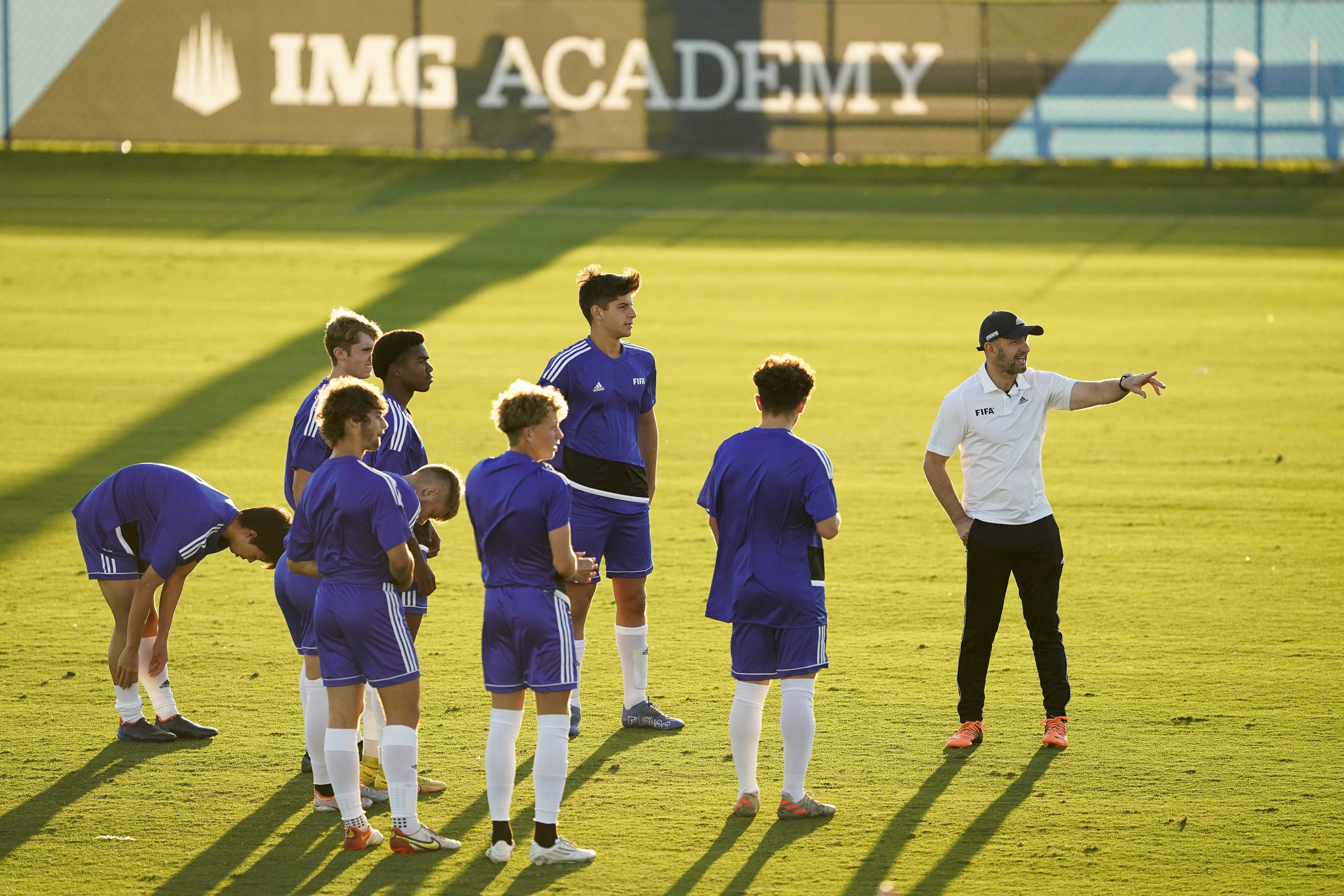
For the purpose of this article, we have selected six drills to demonstrate Circuit 4. The drills are performed on a small sized grid by boys in the U-15 age group and feature distances of between 15 and 30 metres in the sprint/HSR zones per player per repetition. In almost all instances, the video footage of the drills feature sequences involving both 1 and 2 balls in rotation.
A table containing the speed metrics and workload intensity is provided at the end of each session plan. It offers approximate figures regarding the distance covered in the sprint/HSR zones and information on the intensity of the exercises relative to the player numbers. A table detailing the player starting positions is also provided for all drills to ensure that all players (from a total of five to 16) take up the correct starting position.
Set-up for all drills
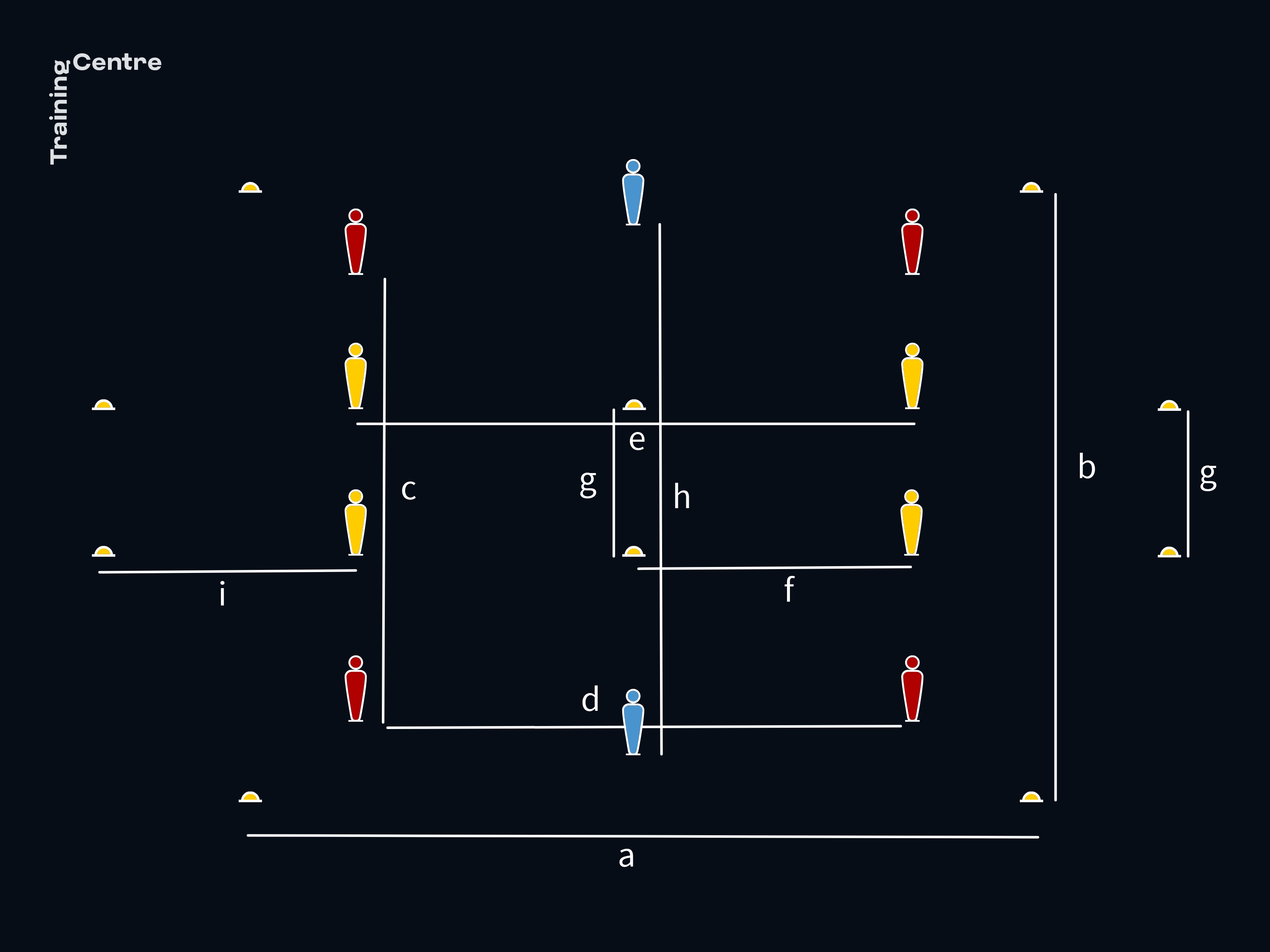
- Lay out a 40x35m grid using discs or cones (a and b).
- Mark out a 30x25m area inside the grid using mannequins (c and d).
- From the midpoint of the grid, create three 6 metre wide gates: 2 using mannequins placed 25m apart (e) at either end of the grid and 1 using flat discs at the midpoint. The mannequin gates should lie 12.5m from the middle gate (f).
- Place 2 mannequins at the midpoint of both a lines, positioning them 35m apart (h).
- Set up two 6-metre wide starting gates (g) using flat discs/cones 12.5m behind the midpoint of both b lines (i).
- If no mannequins are available, a mixture of poles, cones or flat discs may be used instead.

Drill duration
NB: for drills that require 2 sets, each set should be performed for half of the maximum stated duration.
- 5 players (10 players with 2 balls): 6-7 minutes ball rolling time
- 6 players (12 players with 2 balls): 7-8 minutes ball rolling time
- 7 players (14 players with 2 balls): 8-9 minutes ball rolling time
- 8 players (16 players with 2 balls): 9-10 minutes ball rolling time
Approximate workload intensity (slight variations between drills 1-4)
- 5 players (10 players with 2 balls): very high to high
- 6 players (12 players with 2 balls): high to medium
- 7 players (14 players with 2 balls): medium to low
- 8 players (16 players with 2 balls): low
Coaching points that apply to all drills
- Give players 1-2 minutes to find their tempo and familiarise themselves with the scenario, before gradually raising the tempo and intensity.
- Devote a period of time (minimum of 4 minutes) during each drill to focus on high tempo, correct technique, technical balance (two footedness) and the reinforcement of awareness habits. Where a drill requires 2 sets, ensure that a total of at least 4 minutes are devoted to these elements.
- The drill duration relates to ball rolling time. Stop the watch if the drill is interrupted for more than a few seconds.
- Encourage players to move quickly between positions. This is particularly relevant when there are few players involved in the drill, e.g. 5 6 players with 1 ball or 10 12 players with 2 balls.
- Drills 2 and 4 do not involve full left and right rotations. As a result, in order to achieve complete technical balance, the second set should be performed in the opposite direction to the first.
- Place the emphasis on playing a quality pass into the path of the next player in the sequence.
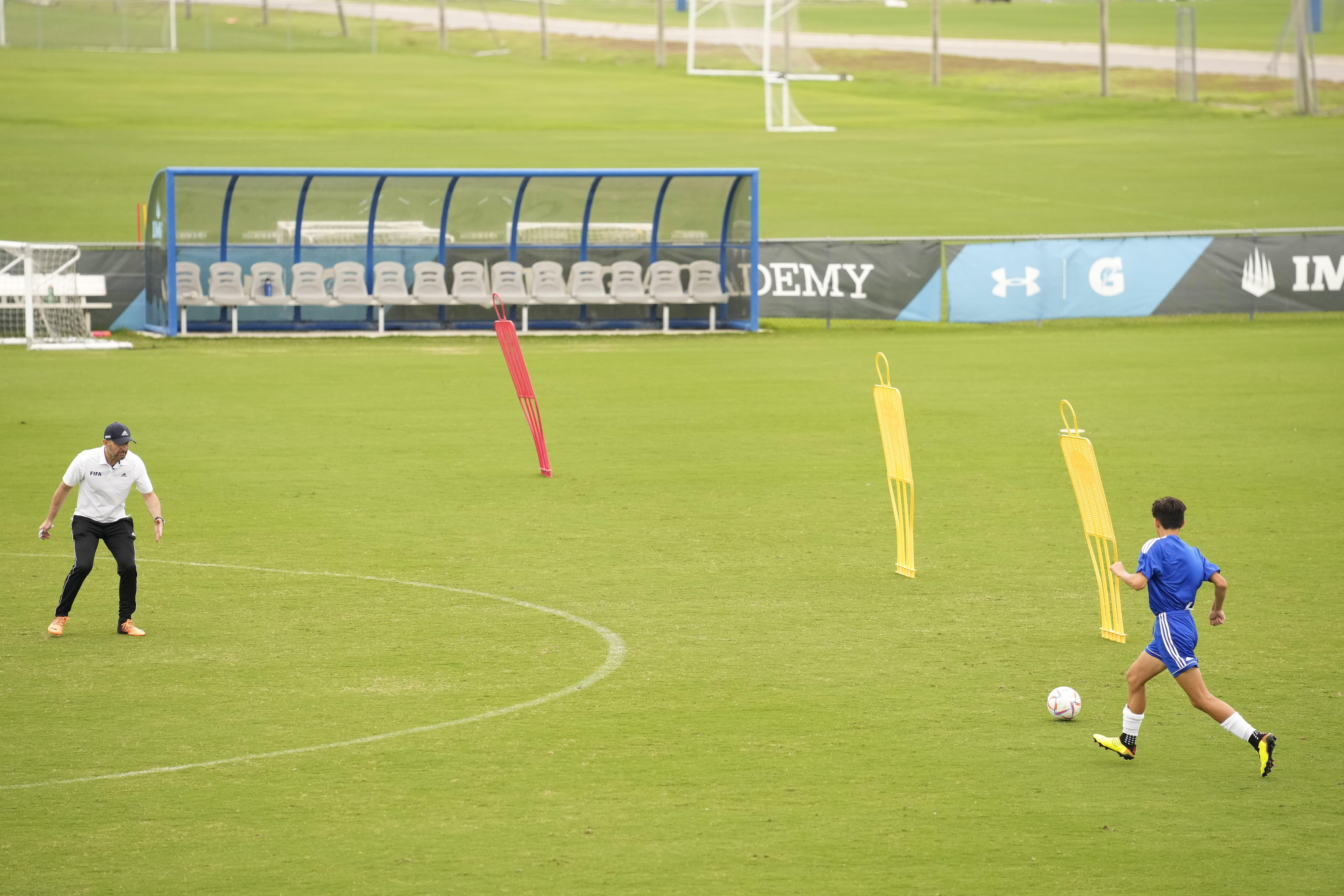
- Players should play with their heads up, scanning the area they are receiving the pass from and the intended destination of their pass.
- When performing the drills with 5 players, a coach/server is required at the starting positions at both ends of the grid to play the first pass in each rotation. When 6 players are involved, a coach/server is required to permanently occupy one of the starting positions.
- To ensure continuous, uninterrupted ball rotation, a minimum of 20 balls is required (10 at each starting position).
- Where a session involves a particular focus on player positioning, the drills offer the flexibility to allow players to remain in the same position, i.e. defenders and midfielders can play passes 2 and 3, with attacking midfielders and forwards making the runs that offer them exposure to the sprint/HSR zones. However, this will result in large disparities in speed metrics and intensity levels between individual players. In addition, it will also pose a challenge for the coach in terms of ensuring that the sprint/HSR workloads are well distributed amongst the players. Rotating players between positions represents the most effective means to achieving a high volume speed metric outcome for all players.
Drill 1: moving into space half turned forward to receive before finding the deep lying runner with a long diagonal pass
-
A plays an angled vertical pass wide of the mannequin gate to B.
-
B moves quickly wide of the gate, shifting the ball forward into space with their first touch, before playing a long range diagonal pass into C’s sprint/HSR path.
-
C makes a powerful run from the deep, wide starting position in coordination with the movement and passing interaction between A and B.
-
After latching on to B’s pass, C plays a cross field pass towards A’.
-
A’ turns out and repeats the sequence from the starting position at the opposite end of the grid.
-
With 2 balls in rotation, the first passes are played simultaneously by A and A’ at opposite ends of the grid.
-
Every player follows their pass to ensure player rotation.
-
A becomes B.
-
B becomes C.
-
C becomes A’.
-
When 5 or 6 players are involved in the drill, coaches/servers are required to permanently occupy the A/A’ starting positions. Where the coaches/servers occupy both starting positions, the players rotate between positions B and C.
-
Place the emphasis on playing a quality pass into the path of the next player in the sequence.
-
This drill promotes technical balance, requiring the use of the left and right foot in equal measure.
-
Whenever possible, A should meet C’s pass early and look to play a first time pass into B
-
To reinforce good footballing awareness habits, B should be encouraged to scan across to C before receiving the ball from A.
-
B should receive the ball half turned forward, while simultaneously lifting their head up and playing the long diagonal pass into C’s path.
-
To promote technical balance, B should be encouraged to use both their left and right foot to play the long diagonal pass from either end of the circuit. B should use the most appropriate foot at all times to increase the efficiency of the sequence.
-
To reinforce good footballing awareness habits, C should scan across to B to time their run in the HSR zone to meet B’s pass.
-
When playing the left to right cross field pass, C should be encouraged to use their left foot to play the ball into the forward path of A’. The opposite applies for the right to left cross field pass, with the emphasis placed on right foot passing.
-
C: each individual acceleration should cover a distance of approximately 25m in the sprint/HSR zones.

Drill 2: turning forwards to play a vertical pass to feet and turning out to play a vertical pass into the runner’s path
-
A plays an angled vertical pass wide of the mannequin gate to B.
-
B moves quickly wide of the gate, shifting the ball into the forward space with their first touch, before playing a long range vertical pass angled to wide of the opposite end gate into C’s movement path.
-
C moves quickly wide of the gate on the half turn to play a short pass angled into D’s forward movement.
-
D nudges the ball forwards before playing a long range vertical pass angled into E’s running path.
-
E makes a powerful run in the sprint/HSR zone from the deep, wide starting position, timed in coordination with the movement and passing interaction of C and D, before latching on to D’s pass and playing a cross field ball into the forward movement of the next player A.
-
The sequence now alternates to the opposite side of the circuit.
-
With 2 balls in rotation, the first passes are played simultaneously by the players positioned at opposite ends of the circuit (A at the start position and D at the opposite end position).
-
Every player follows their pass to ensure player rotation.
-
A becomes B.
-
B becomes C.
-
C becomes D.
-
D becomes E.
-
E becomes the next A.
-
When 5 players are involved in the drill, coaches/servers are required to occupy one or both of the A/A’ starting positions.
-
Place the emphasis on playing a quality pass into the path of the next player in the sequence.
-
With 1 ball in rotation, this drill promotes technical balance, requiring the use of the left and right foot in equal measure. When the drill is performed with an even number of players, players constantly rotate to the same side of the circuit. Coaches should ensure that players rotate to play on both the left and right sides of the circuit. When performed with an odd number of players, this rotation occurs automatically.
-
With 2 balls in rotation, individual clockwise or anticlockwise rotations should be implemented. To promote the technical balance of two‑footedness, 2 sets of this drill are required: 1 clockwise and 1 anticlockwise.
-
When 5 players are involved, a coach or server is required to permanently occupy the starting position to play the first pass.
-
Whenever possible, A should meet E’s pass early and look to play a first time pass into B.
-
To reinforce good footballing awareness habits, B should be encouraged to scan across to C before receiving the ball from A.
-
B should receive the ball half turned forward, while simultaneously lifting their head up before playing the vertical pass into C’s path.
-
To promote technical balance, B should be encouraged to use both their left and right foot to play the vertical pass to C. B should use the most appropriate foot at all times to increase the efficiency of the sequence.
-
C should time their movement in coordination with B’s forward touch.
-
To reinforce good footballing awareness habits, C should be encouraged to quickly scan back to D before receiving B’s pass.
-
To promote technical balance, D should be encouraged to use both their left and right foot to play the long range diagonal pass to E. D should use the most appropriate foot at all times to increase the efficiency of the sequence.
-
E should scan towards D to time their run in the sprint/HSR zones when latching on to D’s pass.
-
When playing the left to right cross field pass into A’s forward movement, E should be encouraged to use their left foot. The opposite applies for the right to left cross field pass, with the emphasis placed on right foot passing.
-
E: each individual acceleration should cover a distance of approximately 25m in the sprint/HSR zones.

Drill 3: stepping in and driving forwards before playing a vertical pass to the runner moving away from the ball
-
A drives forward with the ball towards the mannequin gate before playing a vertical pass towards B’s angled run.
-
B receives the ball on the half-turn, wide of the opposite end mannequin gate, and shifts it into the forward space with their first touch to play an angled pass into C’s forward path.
-
C meets the ball with a vertical pass played in towards D’s darting infield run.
-
D makes a short acceleration from the wide mannequin position in time with C’s movement and passing coordination.
-
Latching on to C’s pass, D plays a short diagonal pass into the forward path of the next player A.
-
With 1 ball in rotation, the sequence now alternates to the opposite side of the circuit.
-
With 2 balls in rotation, the sequence begins with a pass played simultaneously by the players positioned at opposite ends of the circuit (A at the first start position and C at the opposite end position).
-
Every player follows their pass to ensure player rotation.
-
A becomes B.
-
B becomes C.
-
C becomes D.
-
D becomes the next player A.
-
With 1 ball in rotation, this drill promotes technical balance, requiring the use of the left and right foot in equal measure. When the drill is performed with an even number of players, players constantly rotate to the same side of the circuit. Coaches should ensure that players rotate to play on both the left and right sides of the circuit. When performed with an odd number of players, this rotation occurs automatically.
-
With 2 balls in rotation, individual clockwise or anticlockwise rotations should be implemented. To promote the technical balance of two-footedness, two sets of this drill are required: 1 clockwise and 1 anticlockwise.
-
Place the emphasis on playing a quality pass into the path of the next player in the sequence.
-
Whenever possible, A should step in to meet the ball early and then drive towards the mannequin gate with their head up before playing the vertical pass towards B.
-
To promote technical balance, encourage A to use their left and right foot to play both the left and right angled vertical passes to B. A should use the most appropriate foot at all times to increase the efficiency of the sequence.
-
To reinforce good footballing awareness habits, B should be encouraged to scan across to C before receiving the ball from A.
-
B should receive the ball half turned forward while simultaneously lifting their head up before playing the short diagonal pass towards C.
-
B should be encouraged to use their left foot when passing to C from the left side of the mannequin gate and their right foot when passing to C from the right side of the mannequin gate. B should play their pass into C’s path.
-
When playing the vertical ball angled to the right of the mannequin gate, C should be encouraged to shift the ball forwards to the right and play a right footed pass into D’s running path. The opposite applies when playing the vertical ball angled to the left of the mannequin gate, with left footed passing to be encouraged.
-
To reinforce good footballing awareness habits, D should scan across to C to time their infield acceleration to meet C’s pass.
-
When playing the short diagonal pass angled to the left to A, D should be encouraged to use their right foot. The opposite applies for the right diagonal pass to A, with the emphasis on left foot passing.
-
B and D: should cover a combined distance of approximately 20m in the sprint/HSR zones.
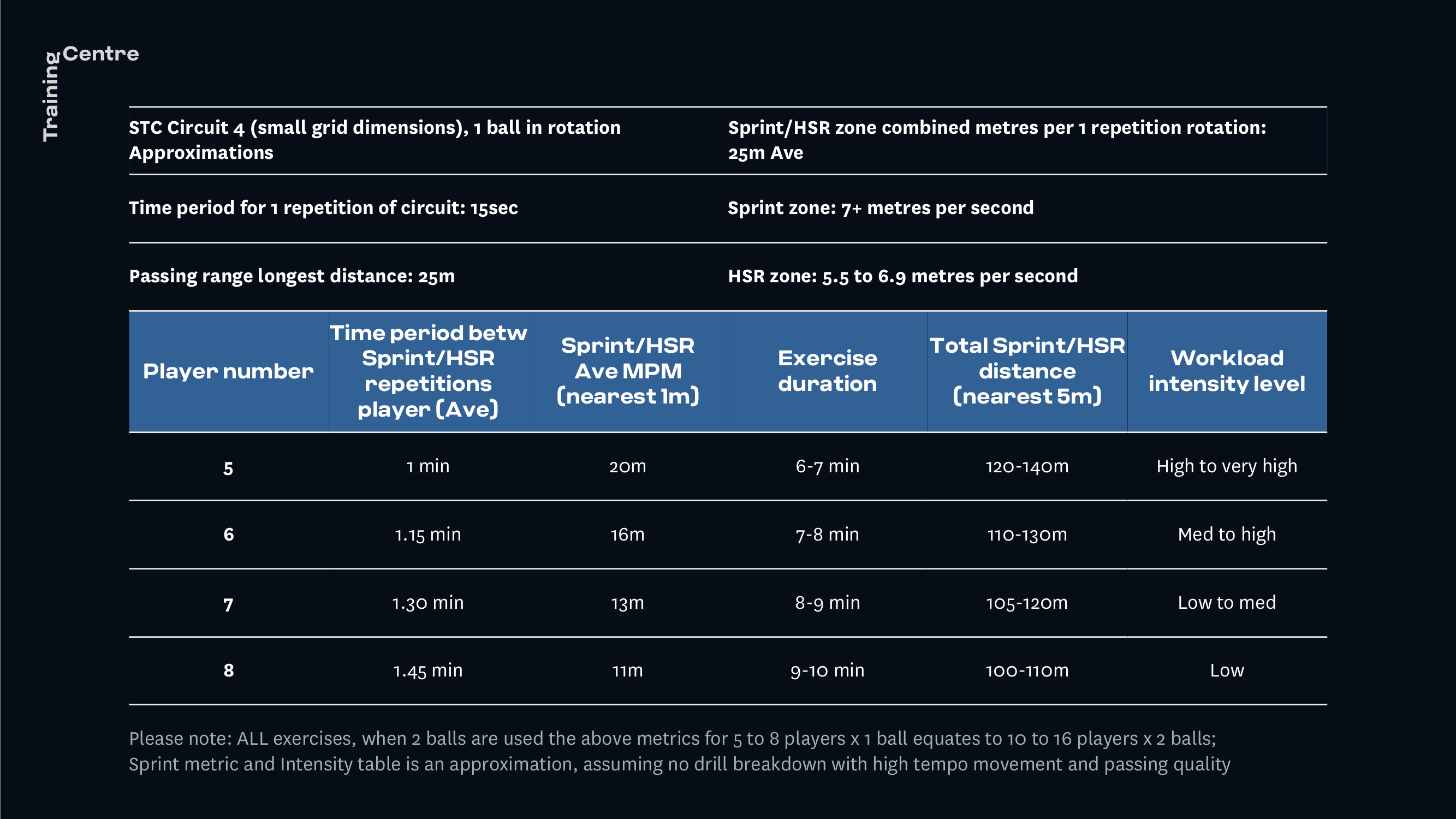
Drill 4: turning out to play a give and go before playing an angled vertical pass to the runner in behind
-
A moves wide to play a one two with B towards the corner mannequin.
-
B plays a short angled return ball into A’s forward run.
-
A latches on to the ball to play a first time, long, vertical pass angled into C’s path.
-
C makes a run in the sprint/HSR zones from behind the first line of mannequins to beyond the last line and connects with the ball to play a diagonal cross field pass into the path of the opposite end player A’ for the sequence to be repeated.
-
With 2 balls in rotation, the first passes are played simultaneously by A and A’ at opposite ends of the circuit.
-
Every player follows their pass to ensure player rotation.
-
A becomes B.
-
B becomes C.
-
C becomes A’.
-
When 5 or 6 players are involved in the drill, coaches/servers are required to permanently occupy either one or both of the A/A’ starting positions. When coaches/servers occupy both starting positions, the players rotate between positions B and C.
-
Place the emphasis on playing a quality pass into the path of the next player in the sequence.
-
To promote the technical balance of two footedness and efficiency of movement, 2 sets of this drill are required: 1 clockwise and 1 anticlockwise.
-
To reinforce good footballing awareness habits, A should scan across towards B before receiving the ball from C’.
-
When turning to play out towards the left side, A should be encouraged to use their left foot. The opposite applies when turning out to the right, with the emphasis on right foot passing.
-
A is encouraged to use both their left and right foot to play the left and right angled vertical passes to B, and should use the most appropriate foot at all times to increase the efficiency of the sequence.
-
C should scan across to A to time their run in the sprint/HSR zones in coordination with the movement and passing interaction between A and B.
-
When playing the left to right cross field pass, C should be encouraged to use their left foot. The opposite applies for the right to left cross field pass, with the emphasis on right foot passing.
-
C should cover a combined distance of approximately 25m in the sprint/HSR zones.
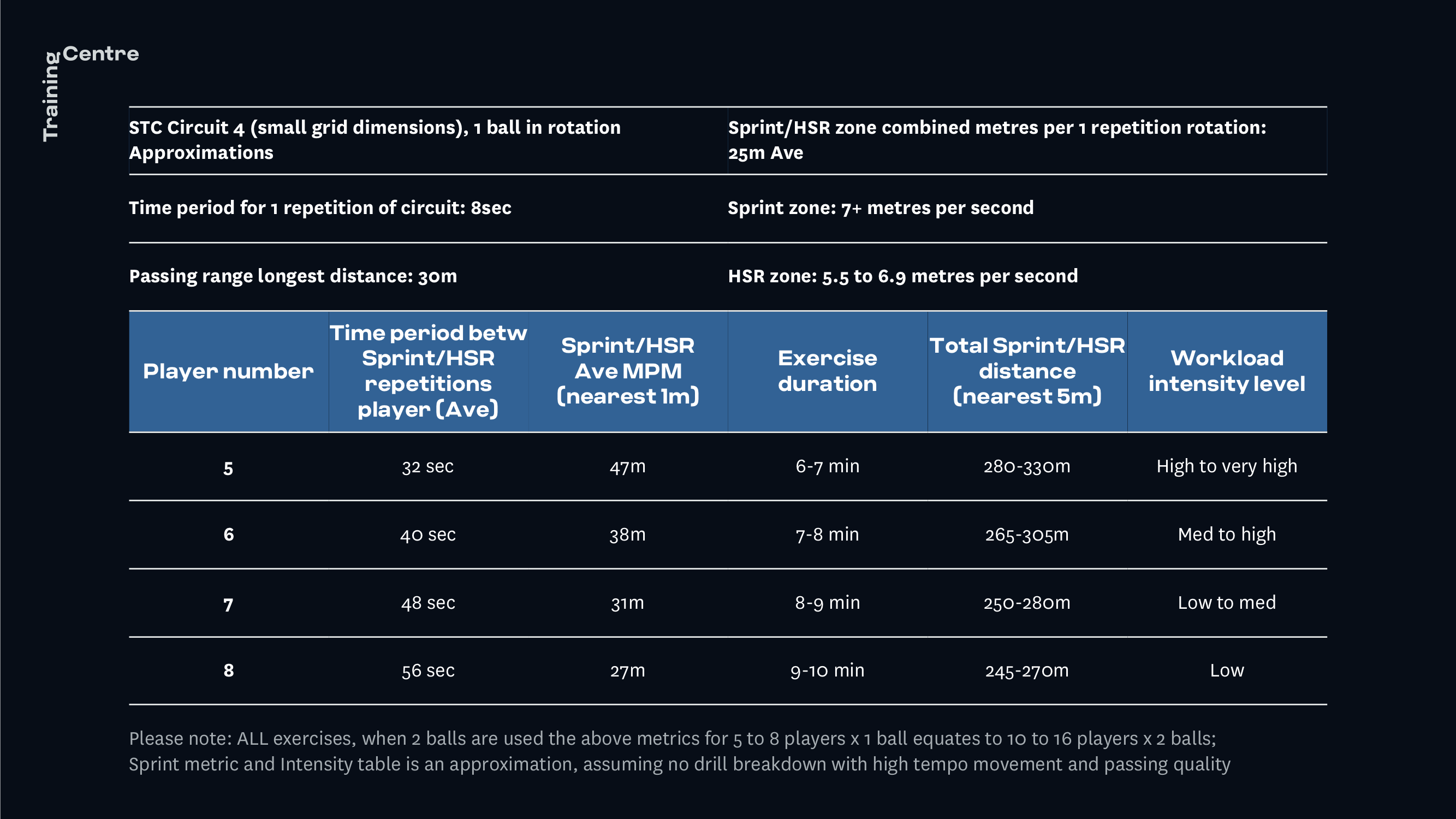
Drill 5: penetrating infield runs between the lines and in behind off the same line as the passer
-
A plays an angled vertical pass towards B’s infield acceleration path.
-
B makes an infield run off the same line of play as A, before latching on to the pass and driving further infield to play a sweeping diagonal cross field pass to meet C’s run in behind.
-
C sets off from the wide middle mannequin and accelerates in behind to connect with B’s pass, before playing a diagonal cross field pass into the path of the opposite end player A’ for the sequence to be repeated.
-
With 2 balls in rotation, the first passes are played simultaneously by A and A’ at opposite ends of the circuit.
-
Every player follows their pass to ensure player rotation.
-
A becomes B.
-
B becomes C.
-
C becomes A’.
-
When 5 or 6 players are involved in the drill, coaches/servers are required to permanently occupy either one or both of the A/A’ starting positions. When coaches/servers occupy both starting positions, the players rotate between positions B and C.
-
Place the emphasis on playing a quality pass into the path of the next player in the sequence.
-
This drill promotes technical balance, requiring the use of the left and right foot in equal measure.
-
To reinforce good footballing awareness habits, A should scan across towards B before receiving the ball from C’, and lift their head up before playing the vertical pass.
-
When turning out towards the left to play the left angled vertical pass to B, A should be encouraged to use their left foot. The opposite applies when turning out to the right, with the emphasis on right foot passing.
-
B should scan towards A to time their short infield acceleration in coordination with A’s movement and pass.
-
To promote technical balance, B should be encouraged to use their left and right foot to play both the left and right sided cross field diagonal passes to C and should use the most appropriate foot at all times to increase the efficiency of the sequence.
-
C should scan towards B to time their run in the sprint/HSR zones in coordination with B’s movement and pass.
-
To promote technical balance, when playing the left to right cross field pass, C should be encouraged to use their left foot. The opposite applies for the right to left cross field pass to A, with the emphasis on right foot passing.
-
B and C should cover a combined distance of approximately 25m in the sprint/HSR zones.
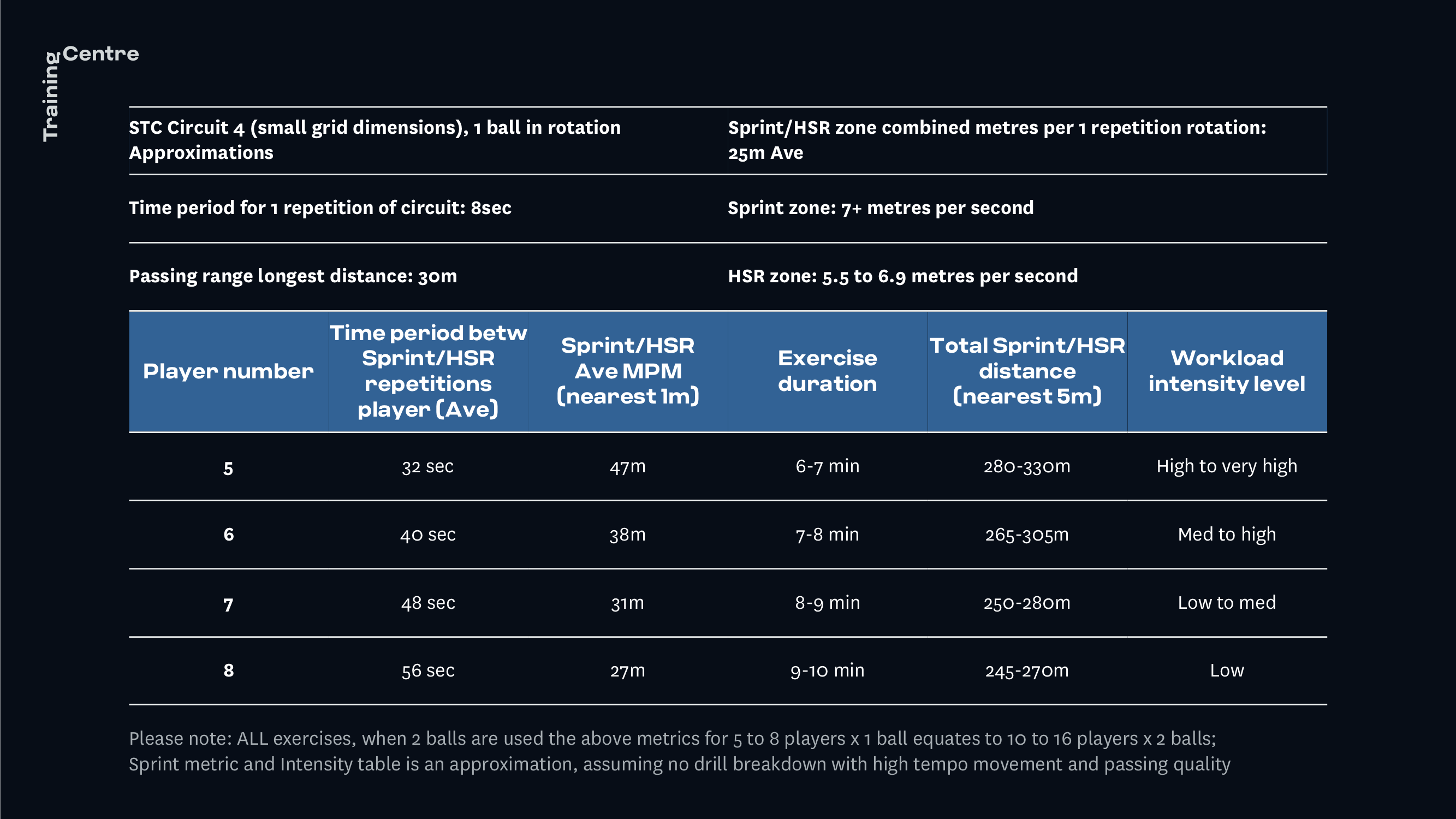
Drill 6: finding movement between lines before playing a cross field pass
-
A turns out to play a diagonal pass towards the wide mannequin and into C’s path.
-
C is positioned out wide on the same line of play as A and makes a short acceleration, meeting the ball beyond the corner mannequin with a give and go infield into B’s feet, followed by a run in the HSR zone beyond the middle mannequin to chase down the return ball.
-
C plays a first time, cross field pass into the path of the next player A’.
-
The sequence is then repeated from the opposite side of the grid.
-
With 2 balls in rotation, the first passes are played simultaneously from the players at opposite ends of the grid: A and A’.
-
A becomes B.
-
B becomes C.
-
C becomes A’.
-
When 5 or 6 players are involved in the drill, coaches/servers are required to permanently occupy either or both of the A/A’ starting positions. When coaches/servers occupy both starting positions, the players rotate between positions B and C.
-
Place the emphasis on playing a quality pass into the path of the next player in the sequence.
-
To promote the technical balance of two footedness and efficiency of movement, 2 sets of this drill are required: 1 clockwise and 1 anticlockwise.
-
To reinforce good footballing awareness habits, A should scan across towards C before receiving the ball from C’.
-
When turning to play the left diagonal pass to B, A should be encouraged to use their left foot. The opposite applies when turning to the right, with the emphasis on right foot passing.
-
C should scan towards A to time the short acceleration in coordination with A’s movement and pass.
-
To promote technical balance, when playing the left-to-right cross-field pass, C should be encouraged to use their left foot. The opposite applies for the right-to- left cross-field pass, with the emphasis on right foot passing.
-
C should cover a total distance of approximately 25m in the sprint/HSR zones.














